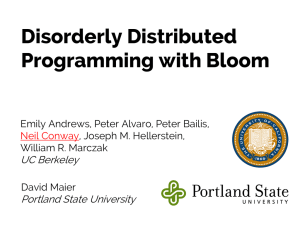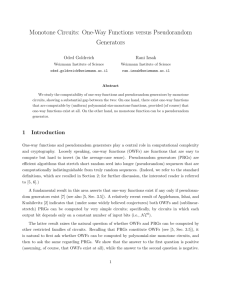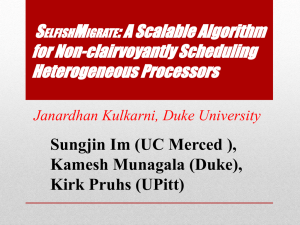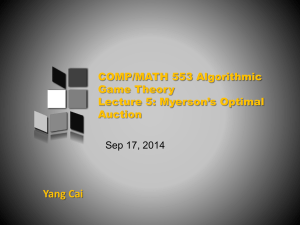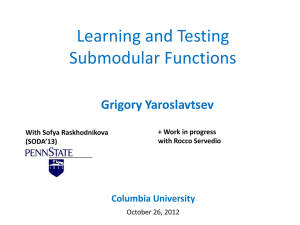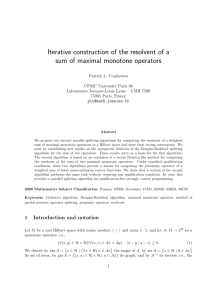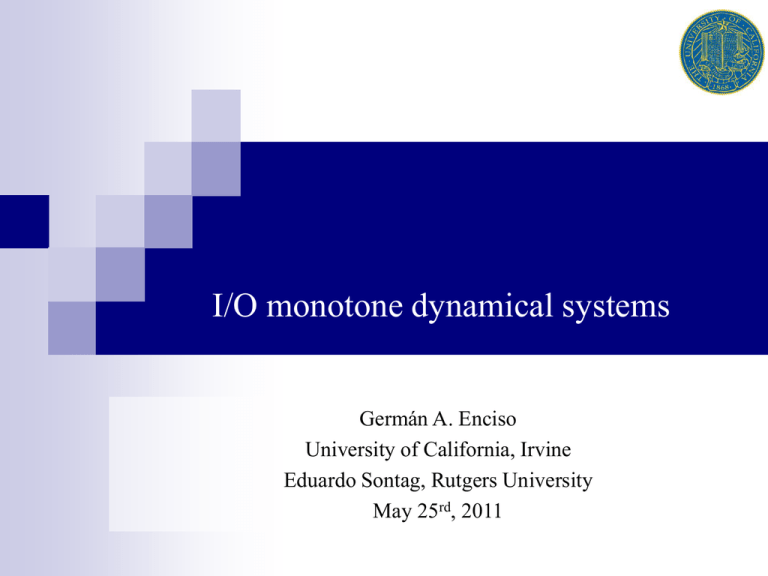
I/O monotone dynamical systems
Germán A. Enciso
University of California, Irvine
Eduardo Sontag, Rutgers University
May 25rd, 2011
BEFORE:
Santa Barbara, January 2003
Having handed to me a photocopied
paper by one Morris Hirsch, to be
deciphered for weeks…
DURING DISSERTATION WORK:
Lots of reading, and regular meetings
Words of encouragement
Teaching by example how
to interact with future
colleagues:
AFTER:
Boston, April 15th 2011
Last day before 60th birthday
(birthday cake pictured below)
ñ
Feliz cumpleaños Eduardo!
Summer 1999, Jersey Shore – by Misha Krichman
Please use YY-filter to zoom in and find out
whose dissertation this is
Introduction: gene and protein networks
systems of molecular interactions inside a cell, modeled using dynamical systems
strongly nonlinear, high dimensional, and noisy
many of the parameters are unknown
but: often the phase space dynamics is one of the following:
Also: ‘consistent interactions’ are common:
Problem:
fi
f
0 for all x or i 0 for all x.
x j
x j
To study the qualitative behavior of models arising in biochemical processes, using
as little quantitative knowledge as possible
Monotone Input/Output Systems
x& f (x,u), y h(x), h : X U
Order defined on both the state space X and the input space U
I/O system is monotone if u(t) v(t) t, x(0) z(0), implies x(t) z(t) t
Positive Feedback Output: x z h(x) h(z)
Negative Feedback Output: x z h(x) h(z)
Assume that the I/S characteristic is well defined, and define S(u) as the I/O
characteristic
Example: Orthant I/O Monotone Systems
Recall orthant order: for some fixed (1,1)n, x z iff xii zii i
x& f (x,u),
u1
u2
y h(x)
x1
u
x2
y1
x1
x2
x3
x4
_
x1
not OK
x1
u
y2
x2
OK
x2
x1
x2
y
y
not OK
OK
Positive parity for all undirected feedback loops, including those involving
inputs, states and/or outputs
Positive feedback: all paths from any input to any output have positive parity
Negative feedback: all paths from any input to any output have negative parity
Positive Feedback Multistability Theorem
Theorem: In the SISO positive feedback
case, each equilibrium of the closed loop
system x’=f(x,h(x)) corresponds to a fixed
point of S(u). Moreover, the stable
equilibria correspond to the fixed points
such that S’(u)<1.
S (u )
u
This result is proved for arbitrary monotone systems with a steady
state response function S(u) in [1]. It is generalized to the case of
multiple inputs and outputs [2], and to systems without a well
defined response function S(u) [3].
[1] D. Angeli, E. Sontag, “Multistability in monotone input/output systems”. Systems and Control Letters 51 (2004),
185-202.
[2] GAE, E. Sontag, “Monotone systems under positive feedback: multistability and a reduction theorem”, Systems
and Control Letters 51(2):185-202, 2005.
[3] GAE, E. Sontag, “Monotone bifurcation graphs”, to appear in the Journal of Biological Dynamics.
Comments:
Only use the general topology of the interaction digraph, plus quantitative
information about the function S(u) -- no need to know all parameter
values!
The function S(u) can potentially be measured in the lab, without precise
knowledge of parameter values
This analysis also stresses the robustness of the system: small parameter
changes will only affect the number of equilibria etc only to the extent that
they alter the steady state response.
Positive Feedback - Example
Consider the following gene regulatory network of k genes:
p&i = K imp,i (qi ) - K exp,i ( pi ) - a2,i pi
q&i = T (ri ) - K imp,i (qi ) + K exp,i ( pi ) - a3,i qi
r&
= H ( pi , pi- 1 ) - a1,i ri
i
i=1...k, p0 := pk
pi : protein i, located in the nucleus
ri: messenger RNA
qi: protein i in the cytoplasm
' k = 1'
' k = 1'
k= 2
u
y
k= 2
k= 3
k= 3
Negative feedback and the Small Gain Theorem (SGT)
Given a SISO I/O monotone system under negative feedback, assume that the I/O
characteristic S(u) is well defined. Suppose that the following condition holds:
Small Gain Condition (SGC): the function S(u) forms a discrete system
un1 S (un )
which is globally attractive towards a unique equilibrium.
Then the closed loop of the system converges globally towards an equilibrium.
D. Angeli, E. Sontag, Monotone control systems, IEEE Trans. on Automatic Control 48 (10): 1684-1698, 2003.
Negative feedback and the Small Gain Theorem (SGT)
A generalization to abstract Banach spaces yields an analog result for:
Multiple inputs and outputs [1]
Delays of arbitrary length [1]
Spatial models of reaction-diffusion equations [2]
Also, using a computational algorithm [3] one can efficiently decompose any signdefinite system as the closed loop of a I/O monotone system under negative
feedback.
[1] GAE, E. Sontag, “On the global attractivity of abstract dynamical systems satisfying a small gain hypothesis, with application to biological
delay systems”, to appear in J. Discrete and Continuous Dynamical Systems.
[2] GAE, H. Smith, E. Sontag, “Non-monotone systems decomposable into monotone systems with negative feedback”, Journal of Differential
Equations 224:205-227, 2006.
[3] B. DasGupta, GAE, E. Sontag, Y. Zhang, Algorithmic and complexity results for decompositions of biological networks into monotone
subsystems, Lecture Notes in Computer Science 4007: Experimental Algorithms, pp. 253-264, Springer Verlag, 2006.
Comments
Monotone systems can also be used to establish the global asymptotic behavior
of certain non-monotone systems
Once again, the result only uses the general topology of the interaction digraph,
plus quantitative information about the function S(u) -- no need to know all
parameter values
This theorem can also be extended to delay and reaction-diffusion equations
Example: stability and oscillations under time delay
x2
Consider the nonlinear delay system
x1 g1 ( x2 ) 1 x1
x1
x3
x2 g 2 ( x3 ) 2 x2
....
xn g n ( x1 (t ) n xn
xn
xn 1
under the assumptions
i 0, i 1...n,
i gi '( x) 0, i 1, 1, 1 ... n 1, gi (0) 0,
i 1...n.
Can allow for multiple delays and gi ( xi 1 ) xi , after a change of variables
The dynamics of this system is governed by a Poincare-Bendixson theorem
Recent examples of this system in the biology literature: Elowitz & Leibler 2000,
Monk 2003, Lewis 2003.
Example: stability and oscillations under time delay
Theorem:
x2
x1
x3
xn
xn 1
Consider a cyclic time delay system under negative feedback, with Hill
function nonlinearities. Then exactly one of the following holds:
I. If the iterations of S(u) are globally convergent, then all solutions of
the cyclic system converge towards the equilibrium, for every value of
the delay (SGT):
x&1 g1 (x2 ) 1 x1
x&2 g2 (x3 ) 2 x2
....
x&n g n (x1 (t ) n xn
m
gi (x) ax m c, or
b x
g(x) a m c
b x
S 2 (u )
xi (t )
un1 S (un )
S (u )
II. Else, periodic solutions exist for some values of the delay, due to a
Hopf bifurcation on the delay parameter.
S 2 (u )
xi (t )
un1 S (un )
S (u)
If some nonlinearities gi(x) have nonnegative Schwarzian derivative, then both I. and II.
might be violated. This is possible even for some (non-Hill) sigmoidal nonlinearites.
GAE, “A dichotomy for a class of cyclic delay systems”, Mathematical Biosciences 208:63-75, 2007.
Unique fixed point for characteristic of negative feedback systems
Question: is it possible to generalize SGT to the case of bistability as in the positive
feedback case, even for MIMO systems?
Theorem: assume
x' f (x,u), y h(x) I/O monotone, negative feedback
n
n
bounded, C2 I/O characteristic (u vS(u) S(v))
S:° °
S'(u ) strongly monotone, hyperbolic for every fixed point u
0
0
a.e. iteration of ui1 S(ui ) is convergent to some s.s. (weak small gain condition)
Then: S(u) has a unique fixed point.
Answer: cannot generalize SGT to the case of bistability for MIMO systems, at least
using the weak small gain condition
On the other hand, this result allows to unify MIMO positive and negative feedback
cases (following slide)
Monotone I/O systems: a unified framework
Theorem: Consider a MIMO I/O monotone control
system under positive or negative feedback, and a I/O
characteristic function S(u) with strongly (anti)monotone
and hyperbolic linearization around fixed points.
Assume:
Weak small gain condition: every solution of the
discrete system
un1 S (un )
converges towards an equilibrium (which may
depend on the initial condition)
S(u)
Then almost every solution of the closed loop system converges towards an equilibrium.
Moreover, the stable equilibria correspond to the stable fix points of the discrete system.
Note: Proof in the MIMO negative feedback case follows from the uniqueness of the
fixed point by previous result
Mixed Feedback? It has been shown that I/O systems that satisfy small gain condition
in the mixed feedback case can be unstable (Angeli et al, work in preparation).
Boolean Monotone Systems
xi (t 1) fi (x(t)), fi :{0, 1}n {0, 1}, i 1... n
system is monotone with respect to the standard order iff each f_i can be written in
terms of AND, OR, with no negations
Which properties of monotone systems hold in the Boolean case?
On average, Boolean monotone systems tend to have shorter periodic orbits than
arbitrary Boolean systems (Sontag, Laubenbacher et al.)
Can any hard bounds be shown for such systems?
Boolean Monotone Systems
Additive lagged Fubini generator:
z(t) z(t p) + z(t q) mod 2
z(t p) XOR z(t q)
*
For appropriate choices of p>q, the
iterations of this system have period
2^p – 1.
*
Theorem: (Just, GAE 2011) For arbitrary 1<c<2, there exists a Boolean monotone
system of dimension n with a solution of period at least c^n. Moreover, the system is
irreducible and has at most two inputs for each variable.
Proof: imitate the non-monotone Boolean network above with a monotone Boolean
network which reproduces its dynamics.
Thanks!
Eduardo Sontag, of course
Hal Smith
Moe Hirsch
Patrick de Leenheer
DIMACS
Questions?
Monotone systems: a definition
Write every variable in the system as a node in a graph, and denote:
f i
x j
xi if the interaction is promoting, i.e.
x j
xi if the reaction is inhibitory, i.e.
f i
x j
x j
0
0
A dynamical system is monotone (with respect to some orthant order) iff every
loop of the interaction graph has an even number of –’s (i.e. positive feedback),
regardless of arc orientation:
x1
x2
x1
x2
x3
x4
not monotone
x3
x4
monotone
Monotone systems: some notes
Monotone systems have very strong stability properties: almost every
solution converges towards an equilibrium [1],[2]
Monotonicity can be established using only ‘qualitative’ information, i.e.
without knowledge of exact parameter values or nonlinearities
Notice: monotonicity is a very strong assumption, which is usually only
satisfied on subsystems of a given network!
Also: given the digraph of the system alone, it is not possible to determine
the number of equilibria and their stability.
[1] M. Hirsch, “Systems of differential equations that are competitive or cooperative II: convergence almost
everywhere”, SIAM J. Math. Anal. 16:423-439, 1985.
[2] GAE, M. Hirsch, H. Smith, “Prevalent behavior of strongly order preserving semiflows”, submitted.


